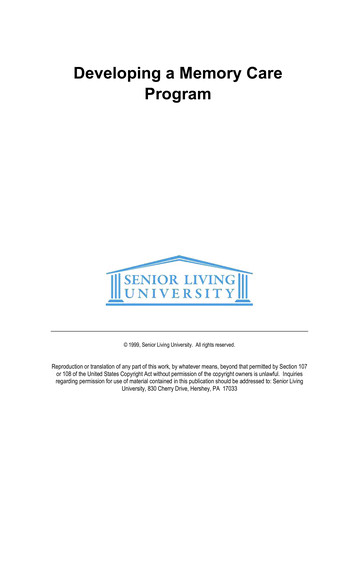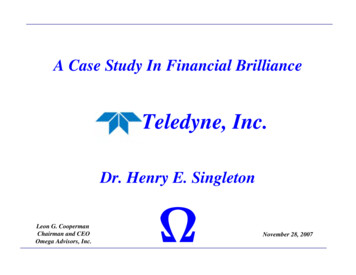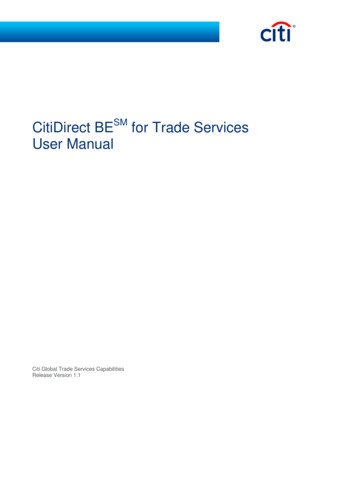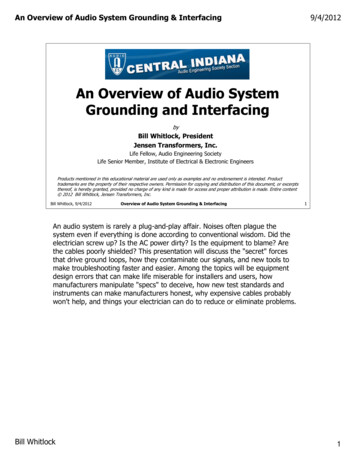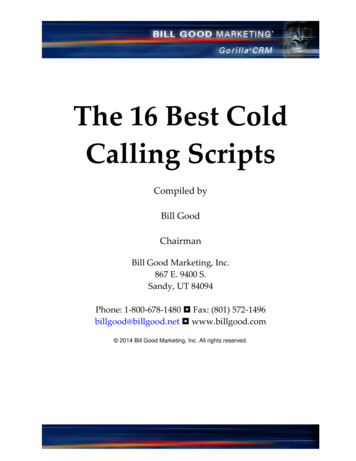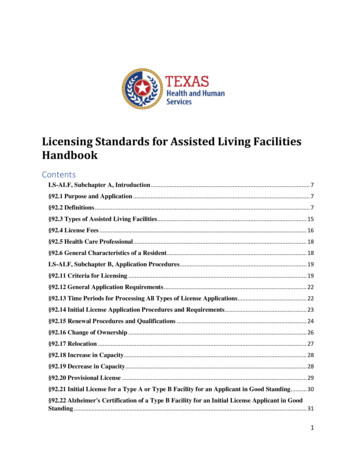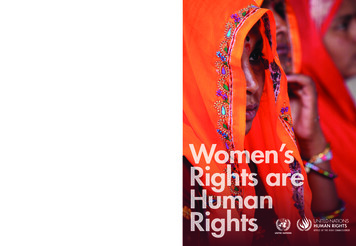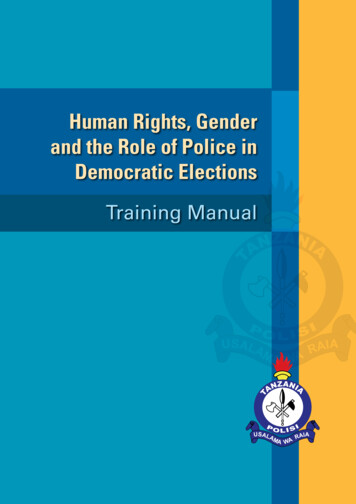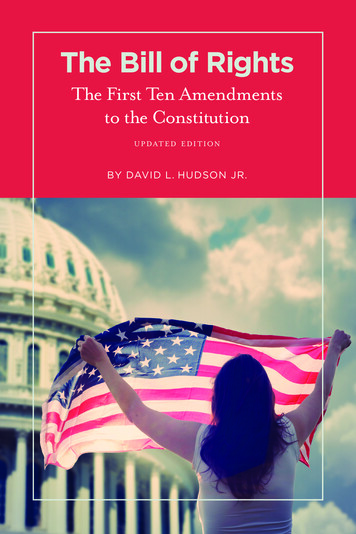
Transcription
The Bill of RightsThe First Ten Amendmentsto the Constitutionu p dat e d e d i t i o nBY DAVID L. HUDSON JR.
The Bill of RightsThe First Ten Amendmentsto the Constitutionupdated editionBY DAVID L. HUDSON JR.the fIRST AMENDMENT PRESS
This book is dedicated toJohn Seigenthaler and Ken PaulsonThe Bill of Rights:The First Ten Amendments to the ConstitutionUpdated Editionby David L. Hudson Jr.Published by First Amendment PressMiddle Tennessee State UniversityMurfreesboro, TN 37132 2002, 2021 David L. Hudson Jr.Cover design 2021 by Leslie HainesCover photo from iStock/narvikkAll rights reserved.Published 2021Printed in the United States of AmericaISBN 978-1-7375681-0-0
ForewordThe National Archives, based in our nation’s capital,houses parchment and principles.It’s there that you’ll find the Declaration of Independence, which in 1776essentially served as a bill of divorce from England and cited “Life, libertyand the pursuit of happiness” as unalienable rights.Also prominent in the archives is the United States Constitution, ratified in1788. It provided this young nation with structure, organizational principlesand a system of checks and balances.It was the promise of another document, however, that ensured ratificationof the Constitution.The Federalists were unable to secure enough states to approve the Constitutionuntil a commitment to the Bill of Rights eased fears and led to support bynine of the 13 colonies, permitting ratification.It was then left to James Madison to draft the Bill of Rights, which wasratified on Dec. 15, 1791.In this updated edition of Professor David L. Hudson Jr.’s The Bill of Rights:The First 10 Amendments, the importance and impact of these key libertiesare explained in detail. Collectively, the Bill of Rights made an extraordinarycommitment to the residents of this new nation in surprisingly concisefashion. Perhaps it is its relative brevity that has allowed it to remain timelyand apply to circumstances never foreseen by the nation’s founders.Yet while a majority of Americans embrace the Declaration of Independenceon the 4th of July with a combination of cookouts and explosive devices, theanniversary of the Bill of Rights is little noted. Why do Americans appear toknow little about the Bill of Rights?One factor is that it was not until 1925 that the U.S. Supreme Court concludedthat elements of the Bill of Rights would apply to the states through a doctrineof incorporation. Until then, our core rights were only protected against theactions of the federal government. Another reason for the lesser visibility ofthe Bill of Rights: a happenstance of history.
On Aug. 21, 1941, with much of Europe and the Soviet Union under siege byGerman troops, Congress passed a joint resolution urging President FranklinDelano Roosevelt to establish a national day to honor the Bill of Rights.As the Los Angeles Times reported on Nov. 28 of that year, “PresidentRoosevelt today called on the American people to observe December 15as ‘Bill of Rights Day,’ to cherish the immeasurable privileges which thecharter guaranteed.” Roosevelt urged Americans to “observe the day withappropriate ceremonies and prayer” and asked government officials to flythe American flag.Just nine days after Roosevelt’s proclamation, the Japanese attacked PearlHarbor. The holiday largely dissipated as we entered World War II. There’ssome irony to this. In an era in which our liberties were under attack aroundthe globe, we lost sight of a holiday that celebrated those freedoms.In the 80-plus years since that initial call for commemoration, the Bill of Rightshas largely been taken for granted by the American people. Yes, Bill of RightsDay is still on the books, but it is rarely acknowledged, let alone celebrated.Table of Contents8Introduction11Chapter 1—The Bill of Rights: What Are They?11 The First Amendment16 The Second Amendment17 The Third Amendment18 The Fourth Amendment20 The Fifth Amendment24 The Sixth Amendment25 The Seventh AmendmentThe downside of this lack of interest and knowledge is twofold: We tend totake these liberties for granted, and if we’re not aware of their true import,then we won’t be vigilant when these core liberties are in danger. Of course,the best avenue for transforming a vague understanding of the Bill of Rightsinto a real appreciation is the classroom.26 The Eighth AmendmentThat’s why the First Amendment Press is pleased to publish ProfessorHudson’s accessible and thoughtful Bill of Rights.35 Chapter 3— How the Constitution andThis book is written in a clear and concise manner and should hold specialappeal to young citizens in the making.41This nation does an extraordinary job of celebrating its independence fromEngland. It’s unfortunate, though, that we don’t expend similar energy on adocument that essentially declared our independence from our own government. This entire country would benefit from lessons in liberty that illuminatethese essential rights and elevate our appreciation of what truly makesAmerica special.Ken PaulsonDirector, Free Speech Center27 The Ninth Amendment28 The Tenth Amendment29 Chapter 2— Ancestry of the Bill of Rightsthe Bill of Rights DevelopedChapter 4— The Father of the Bill of Rights45 Chapter 5— Amending the U.S. Constitutionto Include the Bill of Rights52 Chapter 6— The Bill of Rights in Action67 Conclusion
IntroductionToo often we in the United States take our precious individual libertiesfor granted. All students and citizens should stop and think for a momentabout how the world would be without these liberties.Consider the following example. A public junior high school teacher assignsher students a creative writing project. The teacher instructs the students thatthe poem must contain a theme arising out of a major current event that hashad a major impact on the students. One student decides to write a poemabout school violence in the wake of several recent school shootings, includingthe 2018 tragic school shooting at Marjorie Stoneman Douglas High Schoolin Parkland, Fla. The student posts her poem on social media.The poem expresses the inner demons of a student who feels alienated by hispeers. In his mind, the student’s fictional character debates whether he shouldbecome the bully and lash out violently against his tormentors. Anotherstudent downloads the poem and shows it to a teacher at school. The teachermistakenly believes the poem to be a threat. Theteacher shows the poem to the principal andschool resource officer. The three officials thencollectively decide that the student poses animmediate risk to himself and others.The school officials strip-search the student,interrogate him for several hours, and call thepolice. The school officials then expel thestudent permanently, citing a “zero tolerance”policy against violence.The police interrogate the student for several hours withoutreading him his rights or allowing him to call his family. They lock the studentin a juvenile detention center cell, where he remains incarcerated until anemergency court hearing.In the meantime, the police enter the student’s home, search his room, andseize his home computer without a warrant. The police then force the studentto reveal the passwords to his social media accounts to search for moreinformation and perhaps other violent-themed posts.—8—In this scenario, the public school officials and the police violated the student’sconstitutional rights. They infringed on his freedom of speech, freedom fromunreasonable searches and seizures, and freedom from self-incrimination.What if the police could enter your home at any time for no stated reasonand search through your personal possessions? What if you could be imprisoned merely for writing an article that criticizes a local politician?Imagine if you could be put to death for a minor criminal offense, such asshoplifting a candy bar. Imagine if you could be thrown into jail, denied anattorney, and not be able to confront your accusers.Imagine if the government could command that you practice a certain religionor could banish you out of the country. Consider if you could be declaredguilty without a jury trial.Such was—and is—the plight of millions of people in countries all over theglobe. Fortunately, in America we have individual liberties ensured by law.Sometimes, government officials violate people’s constitutional rights. But atleast in this country we usually have a remedy in our United States Constitution.Our Constitution—and particularly the first Ten Amendments—provide uswith what our fourth president, James Madison, called “the great rights ofmankind.” These Ten Amendments are called the Bill of Rights.In his book The Life of the Law, attorney Alfred M. Knight argues that our“legal system” is the most important and unique part of our culture. He writes:“Nothing like it has ever been seen before on this planet so far as we know. It isdistinguished above all else by its breathtaking generosity to the individual.” 1The Bill of Rights symbolizes this “breathtaking generosity.” It safeguardsour constitutional rights. United States Supreme Court Justice Hugo Blackwrote that the Bill of Rights “protect(s) and safeguard(s) the most cherishedliberties of a free people.” 2My hope is that the pages that follow will serve as a ready reference and quickexplanation for anyone who holds that these rights are so basic, andso crucial, to our life as American citizens.David L. Hudson Jr.1 Alfred H. Knight, The Life of the Law, (New York: Crown Publishers, Inc. 1996) p. 4.2 Gault, Application of, 387 U.S. 1, 62-63 (1967)( J. Black, concurring).—9—
CHA PTER 1The Bill of Rights:What Are They?The United States Constitution sets out the structure of our government.It divides various powers among the three branches of the federal government — the executive, legislative and judicial.The Bill of Rights was added to the Constitution in part to ensure that thepowers of the federal government would not trample upon individual liberty.The first eight amendments to the United States Constitution are designedto protect individuals from abuse by federal government officials. The ninthand tenth amendments set out the division of powers between the federalgovernment and various state governments. The Fourteenth Amendmentensures that most of the rights contained in the first eight amendments ofthe Bill of Rights apply to state and local government officials.The First Amendment“Congress shall make no law respecting an establishmentof religion, or prohibiting the free exercise thereof; or abridging the freedom of speech, or of the press; or theright of the people peaceably to assemble, and to petitionthe Government for a redress of grievances.”The First Amendment serves as our blueprint for personal freedom. Itensures that we live in an open society. The First Amendment contains fivefreedoms: religion, speech, press, assembly and petition.Without the First Amendment, religious minorities could be persecuted orthe government could establish a single, national religion. The press could notcriticize government and citizens could not mobilize for social change. Thiswould mean we would lose our individual freedom.— 10 —— 11 —
Freedom of ReligionThe first two clauses of the First Amendment — “respecting an establishment of religion or prohibiting the free exercise thereof ” — are the religionclauses. The first is the Establishment Clause. The second is the Free ExerciseClause. Together, these clauses require that the government act in a neutralmanner when it comes to religion.The Establishment Clause provides that church and state remain separateto a certain degree. In a letter to the Danbury Baptists in 1802, PresidentThomas Jefferson spoke of a “wall of separation between church and state.”The U.S. Supreme Court used Jefferson’s “wall of separation” metaphor todescribe the meaning of the Establishment Clause.1James Madison, Jefferson and some of our other Founding Fathers desired toplace some distance between church and state to prevent American politicalleaders from acting like English monarchs who were intolerant of otherreligious views.King Henry VIII was a prime example. He broke away from the CatholicChurch in 1531 after the pope refused to support his divorce from Catherineof Aragon. Henry established the Protestant Church of England. In 1534,the English Parliament passed the Act of Supremacy establishing Henry asthe head of the Church of England.Later, Parliament passed the Treason Act, which effectively silenced anyonewho spoke out against the King. The act was used to silence religiousdissenters. Religious intolerance seemed to be the standard in much ofEurope, including England. Many people fled England to settle in Americaand the New World because of religious persecution. Religious dissenters inEngland were ostracized, punished and imprisoned.In the 1960s, the United States Supreme Court ruled that public schoolofficials violated the Establishment Clause when they led students in prayer.The Court explained that a reasonable observer would believe that the schoolofficials were advancing or endorsing a certain religion over other religions.Members of religious minorities would be coerced to conform to themajority religion.Historians, judges and members of the public dispute the meaning of theEstablishment Clause. Some believe the clause only meant to prohibit thegovernment from setting up a national church. Others apply the “wall ofseparation” theory more vigorously and disagree with any state involvement— 12 —with religion. They argue that the state cannot grant aid to religious institutions. So-called strict separationists oppose school-voucher programs inwhich parents are given tuition monies for their kids to attend certainschools, including parochial (or religious) schools.The second religion clause of the First Amendment is the Free Exercise Clause.It protects a person’s right to practice religion freely. In 1963, the UnitedStates Supreme Court ruled that South Carolina officials violated thefree-exercise rights of Adele Sherbert, a Seventh-day Adventist who wasfired from her job and denied unemployment benefits because she would notwork on Saturday.2 Seventh-day Adventists believe that the day of worshipis Saturday, not Sunday.In 1990, the Supreme Court decided a case involvinga similar issue. Two Native American drugcounselors claimed their First Amendmentrights were violated when they were deniedunemployment benefits after they were firedfor drug use. The individuals had ingestedpeyote — a hallucinogenic drug — for religious reasons. The two individuals arguedthat, like Ms. Sherbert, they were being punishedfor exercising their religious rights. 3The Court ruled in favor of the state and against the twoformer drug counselors. The high court wrote that the state’s criminal lawagainst drug use was a neutral law of general applicability. The Court foundthere was no religious exemption to fail to comply with the state’s drug laws.Freedom of SpeechThe First Amendment protects the right of free speech, even offensive speech.Our early leaders, known as the Founding Fathers, spoke out mightily againstarbitrary actions by the king of England and the English Parliament, such astax increases. They wanted to ensure that Americans would have the right tocriticize their government.Shortly after World War I, many socialists and anarchists, who disagreedwith the United States’ system of government, were punished for theiranti-war speeches and writings. Justice Oliver Wendell Holmes developed— 13 —
the so-called “clear and present danger” test. Under this theory, a personcould not be punished for his or her speech, unless that speech caused a“clear and present danger.” For example, the government could prohibitspeech that caused an immediate riot.Freedom of speech also applies to more than just oral speech. Certain formsof symbolic speech, or expressive conduct, also receive protection. In the1960s, public high school students in Iowa wore black armbands to school toprotest United States’ involvement in the Vietnam War. The Supreme Courtdetermined in 1969 that the students’ act of wearing the armbands was“closely akin” to pure speech.4Similarly, in 1984, Gregory “Joey” Johnson burned an American flag outsidethe Republican National Convention in a form of political protest. In a 1989decision, the Supreme Court said the act of burning the flag was a form offree expression.The Court held that burning the flag, like wearing the black armbands, wasan effective means of communicating a certain message.Not all speech, however, receives protection. Certain forms of speech receiveno protection. These categories include obscenity and fighting words. Obscenityrefers to speech that depicts hard-core sexual activities in a graphic way.“Fighting words” refers to face-to-face insults that cause an immediate violentreaction. The Supreme Court has determined that these types of speech areharmful and do not contribute meaningfully to the marketplace of ideas.Some people claim that hate speech — speech that targets a particular groupbecause of race or religion — should also be prohibited. Even hateful speechreceives protection under the First Amendment unless it incites imminent,or immediate, lawless action or qualifies as a true threat.Freedom of the PressThomas Jefferson once said that if he had to choose between a governmentwithout newspapers, or newspapers without government, he would nothesitate to “choose the latter.”5A free press is the heart of the First Amendment. The press has historicallyserved as a check upon the government. The press is sometimes referred to asthe “Fourth Estate” because of its important position in society in examiningthe three branches of government — the executive, legislative and judicial.The press in England was not free. English officials passed licensing laws that— 14 —forced writers and publishers to obtain prior approval of their works fromthe Crown before publication.The English monarchy established this system of prior restraint in order toprevent criticism of the king. English courts, including the secret courtknown as the Star Chamber, punished those who engaged in seditious libel.In theory, seditious libel referredto speech that called for treasonagainst the government. Inpractice, seditious libel referred tospeech criticizing the king.A free press isthe heart of theFirst Amendment.In this country, the tradition ofpress freedom began with thecelebrated case in 1735 of John Peter Zenger, who was prosecuted forcriminal libel for criticizing the royal governor of New York, William Cosby.In a landmark legal moment, a jury ignored the prevailing law at the timeand decided that truth was a defense to a libel action. Under current law, astatement cannot be considered libelous if it is true.More than two hundred years later, in 1964, the United States SupremeCourt afforded the press much greater freedom in New York Times Co. v.Sullivan.6 In this case, The New York Times printed an editorial advertisementby the “Committee to Defend Martin Luther King and the Struggle forFreedom in the South.”The ad criticized the actions of certain “Southern violators” and accused themof violating the civil rights of African-American students in Montgomery,Ala. The ad read: “Again and again the Southern violators have answered Dr.King’s peaceful protests with intimidation and violence. They have bombedhis home almost killing his wife and child. They have assaulted his person.They have arrested him seven times.”7Even though he was not named specifically in the ad, L.B. Sullivan, theMontgomery city commissioner in charge of the police, sued the newspaperfor libel (publishing false statements of facts about someone) in the amountof 500,000. The ad contained certain misstatements. For example, Dr. Kinghad been arrested only four times, not seven.An Alabama jury awarded Sullivan 500,000. However, the United StatesSupreme Court reversed the jury verdict against the newspaper. The decision“transformed American libel law.”8 The Court wrote that “debate on publicissues should be uninhibited, robust, and wide-open, and may well includevehement, caustic, and sometimes unpleasantly sharp attacks on governmentand public officials.”9— 15 —
Now, the press faces lawsuits for allegedly violating people’s right to privacy.Celebrities and private individuals sometimes contend that the press wenttoo far in disclosing private information. Caroline Kennedy and EllenAlderman describe this phenomenon as “a clash between the right to be letalone and the right to know, a clash between privacy and the press.”10Freedom of Assembly and PetitionThe last two freedoms of the First Amendment ensure that citizens canassemble together and directly petition the government to call public attention to a certain cause.Over the course of American history, striking workers, civil rights advocates,anti-war demonstrators, and Ku Klux Klan marchers have sought the protectionsof the First Amendment. They sought the right to assemble freely andpetition the government for a redress of grievances. Sometimes these effortshave galvanized public support or changed public perceptions. The freedomof assembly was essential to both the Civil Rights Movement of the 1950sand 1960s and the women’s suffrage movement.11Citizens also have a right to petition the government to correct injustices, orin the words of the First Amendment, for a “redress of grievances.” Thoughprobably the least-known clause of the First Amendment, it arguably hasdeeper historical roots than any other First Amendment freedom. Considerthat two of history’s most venerated documents — the Magna Carta and theDeclaration of Independence — were petitions to kings of England. Eachdocument petitioned the ruler with various complaints.The Second Amendment“A well regulated Militia, being necessary to the security of a free State, the right of the people tokeep and bear Arms, shall not be infringed.”Most of the provisions of the Bill of Rights can be traced to freedoms firstdeveloped in England. The English Bill of Rights in 1689 declares thatindividuals should have the right to bear arms.The great English legal historian William Blackstone wrote in his Commentaries that the right to bear arms was necessary “to protect and maintaininviolate the three great and primary rights of personal security, personalliberty, and private property.”12— 16 —Americans in the late eighteenth century viewed the right to bear arms asnecessary for liberty. Colonists needed firearms for hunting. They also neededweapons when they confronted hostile strangers or foreign enemies in the NewWorld. The right to bear arms was explicitly mentioned in the early stateconstitutions of Pennsylvania, North Carolina, Vermont, and Massachusetts.13Legal historians debate whether the amendment applies to a collective orindividual right. In other words, historians differ on whether the right tobear arms applies to a militia or to each individual. The dispute occursbecause the wording of the amending begins with a preamble mentioning“a well regulated militia.”14The Supreme Court ruled 5-4 in District of Columbia v. Heller (2008) thatthe Second Amendment protected the individual right to keep and beararms.15 The majority rejected the collective-right interpretation of theSecond Amendment.Today, many Americans still own guns for recreation and personal safety.They view the federal government and its laws regulating the sale of handguns and other firearms as infringing on personal freedom. The NationalRifle Association (NRA), for instance, is a powerful group that lobbiesagainst many gun-control laws and on behalf of citizens’ SecondAmendment rights.The downside for many government officials is the high number of handgundeaths each year in the United States – more than any other country not at warin the world. Recent school shootings have increased public awareness aboutfirearms. Many believe that we must limit firearms in the stream of commerce.The Third Amendment“No Soldier shall, in time of peace be quartered in anyhouse, without the consent of the Owner, nor in time ofwar, but in a manner to be prescribed by law.”The Founding Fathers adopted this amendment to prevent the federalgovernment from housing troops in individuals’ homes. In colonial times,the British government would house (or quarter) troops in colonists’ homeswithout their consent. The Quartering Act of 1765 allowed the English tohouse troops in colonists’ homes.This imposed a tremendous burden upon colonists. Imagine if the governmentcould require you to house military troops in your own home.— 17 —
This is the least-significant provision of the Bill of Rights. Today members ofthe armed forces live in communities and on military bases, not in the privatehomes of nonmilitary citizens.The Fourth Amendment“The right of the people to be secure in their persons,houses, papers and effects, against unreasonable searchesand seizures, shall not be violated, and no Warrants shallissue, but upon probable cause, supported by Oath oraffirmation, and particularly describing the place to besearched, and the persons or things to be seized.”A popular saying is a man’s home is his castle. The Constitution safeguardsthis concept of privacy in the Fourth Amendment. This amendment protectspeople from government invasions into their homes and bodies.During the colonial period, British customs officials would obtain searchwarrants called writs of assistance. These writs allowed the officials to inspectall of a colonist’s cargo to prevent smuggling of goods that were to be taxed.These writs of assistance allowed the officials to search and seize whateverproperty they desired without prior approval by a judge or magistrate.In response, the Founding Fathers adopted the Fourth Amendment. Thisamendment generally requires that the police obtain awarrant from a judge before conducting a searchand seizure.The warrant must explain why the police believea search is necessary. The warrant must also statewhat material is being targeted in the search. TheBritish would often use so-called “general warrants” when searching colonists’ property. Ageneral warrant allowed authorities to search all ofperson’s property. The Fourth Amendment generallyforbids the use of general warrants. It requires the policeto state specifically what items they expect to find.In order to obtain a warrant and search a person, the police must have whatis known as “probable cause.” Probable cause means more than just a hunch.— 18 —The police must point to specified evidence showing that the person likely iscarrying certain material.Controversy surrounds the Fourth Amendment because sometimes the policewill violate the rights of a person who is carrying contraband, such as illegaldrugs. A common example is when a police officer discovers drugs on aperson — but only after an unreasonable search or seizure.Our Constitution allows a person illegally searched to file a motion to suppressthe evidence. This is called the exclusionary rule. Judge Benjamin Cardozoexpressed thisconcept when he saidthat “the criminal isfree to go becausethe constable hasblundered.”16 Therationale behind theexclusionary rule isto require lawenforcement officialsto obey the law.Controversy surroundsthe Fourth Amendmentbecause sometimes thepolice will violate therights of a person whois carrying contraband,such as illegal drugs.Public schoolstudents do notpossess the samelevel of Fourth Amendment rights as adults in their homes. In 1985, theUnited States Supreme Court limited the level of Fourth Amendmentprotection for students.17 Normally, police must have probable cause tosearch a person and his or her belongings. However, the high court determined that “the school setting requires some easing of the restrictions towhich searches by public authorities are ordinarily subject.” In that case, theCourt found that it was reasonable to search a student’s purse after a teacherdiscovered two girls smoking in the bathroom.18In recent times, courts have examined numerous Fourth Amendment casesinvolving the searching of people who are suspected of trafficking in drugs.The epidemic of illegal drug use has led some courts to relax the standardsof the Fourth Amendment.However, the Supreme Court in 2001 ruled unconstitutional a South Carolinastate hospital’s practice of drug testing pregnant women and then turningpositive results over to the police for prosecution. The hospital argued thatits program was justified because there is a special need to stop drug use. The— 19 —
majority of the Supreme Court disagreed, finding that the policy led tounreasonable searches.19Fourth Amendment rights are fragile because some people are notwilling to protect the constitutional rights of those whom they feel havecommitted crimes.The Fifth Amendment“No person shall be held to answer for a capital, or otherwise infamous crime, unless on a presentment or indictmentof a Grand Jury, except in cases arising in the land or navalforces, or in the Militia, when in actual service in time ofWar or public danger; nor shall any person be subject forthe same offence to be twice put in jeopardy of life or limb;nor shall be compelled in any criminal case to be a witnessagainst himself, nor be deprived of life, liberty, or propertywithout due process of law; nor shall private property betaken for public use without just compensation.”The Fifth Amendment provides protections for criminal defendants andthe general public in several provisions. The freedoms in the Fifth Amendment include the right to be charged with a serious crime by a grand jury,protection against double jeopardy, the right to remain silent, the right of dueprocess and the right not to have property taken by the government withoutjust compensation.Grand JuryA grand jury consists of a group of everyday citizens who hear a prosecutor’sevidence in
This book is written in a clear and concise manner and should hold special appeal to young citizens in the making. This nation does an extraordinary job of celebrating its independence from England. It’s unfortunate, though, that we don’t expend similar energy on a document that essent

